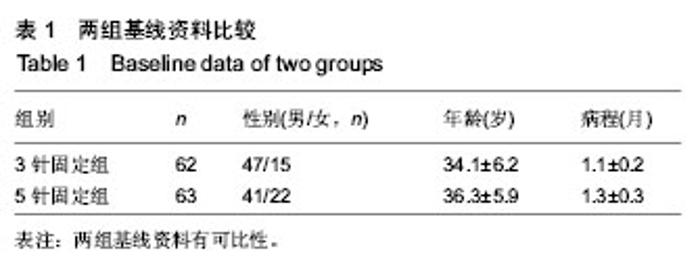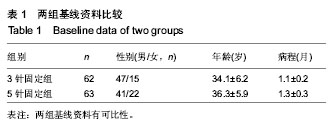Chinese Journal of Tissue Engineering Research ›› 2014, Vol. 18 ›› Issue (42): 6827-6831.doi: 10.3969/j.issn.2095-4344.2014.42.020
Previous Articles Next Articles
Biomechanical characteristics of suturing the ligament end during anterior cruciate ligament reconstruction
Chen Xiao, Huang Jing-min
- Second Arthroscopy Ward of Sports and Injury, Tianjin 300211, China
-
Revised:2014-09-15Online:2014-10-08Published:2014-10-08 -
About author:Chen Xiao, Studying for master’s degree, Second Arthroscopy Ward of Sports and Injury, Tianjin 300211, China
CLC Number:
Cite this article
Chen Xiao, Huang Jing-min. Biomechanical characteristics of suturing the ligament end during anterior cruciate ligament reconstruction[J]. Chinese Journal of Tissue Engineering Research, 2014, 18(42): 6827-6831.
share this article

2 临床应用 Clinical application 2.1 对象和方法 设计:病例回顾性分析。 时间及地点:2013年7月至2014年6月在天津医院运动与损伤关节镜2病区完成。 对象:2013年7月至2014年6月,本科共施行关节镜下前、后交叉韧带重建术315例,选取了其中125例前交叉韧带重建患者进行临床缝线方式拉力比较,男88例,女37例;年龄(35.3±6.7)岁;均为膝关节运动性损伤。 纳入标准:①膝关节运动性损伤患者。②行关节镜下前交叉韧带重建者。③患者对治疗均知情同意,签署“知情同意书”。 排除标准:膝关节骨性关节炎、类风湿关节炎、肿瘤等。 方法:所有患者施行关节镜下前交叉韧带重建,采用改良的Krackow双锁边缝合法(肌腱缝合线由强生公司提供,商品名爱惜康缝线),移植物的胫骨端全部采用缝线固定,经胫骨骨隧道拉出,在保持移植物张力的情况下,胫骨前面挤压螺钉固定。 3针固定组:在2013年12月以前,62例次采用两条缝线双锁边法缝合3针固定,借鉴张春礼[16]方法,第一针贯穿韧带缝合。 康复计划为:术后当日开始直腿抬高训练;术后7 d佩戴交叉韧带型铰链支具,扶双拐患肢不完全负重下地行走,术后2周30°,3周60°,4周90°,5周120°,2个月可完全负重逐步弃拐行走,3个月去支具,然后恢复自由行走,1年后经医生检查允许后可开始参加体育运动。 5针固定组:2013年12月以后的63例采用两条缝线双锁边法缝合5针固定,第一针同样贯穿韧带,术后功能恢复计划同前。 主要观察指标:①随访时行抽屉试验检查前交叉韧带及后交叉韧带功能。②患者满意率。③不良反应及材料宿主反应。 2.2 结果 2.2.1 参与者数量分析 125例患者肌腱重建后随访2-14个月,平均随访6.4个月,无脱落者,按意向性处理分析,全部进入结果分析。 2.2.2 两组基线资料比较 两组前交叉韧带重建患者的性别、年龄、病程等比较差异无显著性意义(P > 0.05),有可比性,见表1。 2.2.3 随访结果 抽屉试验阳性患者2例,患者满意率99%。3针固定组及5针固定组组间比较差异无显著性意义(P > 0.05)。 2.2.4 不良反应及材料宿主反应 未见早期或晚期缝线断裂松脱,患者康复顺利,无意外情况发生;无二次手术、无伤口感染等并发症发生。"

| [1] Lieber RL, Silva PD. Equal effectiveness of electrical and volitional strength training for quadriceps femoris muscles after anterior cruciate ligament surgery. J Orthop Res. 1996; 14(1):131-138. [2] Wright RW, Preston E, Fleming BC,et al.A systematic review of anterior cruciate ligament reconstruction rehabilitation: part II: open versus closed kinetic chain exercises, neuromuscular electrical stimulation, accelerated rehabilitation, and miscellaneous topics.J Knee Surg. 2008; 21(3):225-234. [3] Snyder-Mackler L, Delitto A, Bailey SL, et al.Strength of the quadriceps femoris muscle and functional recovery after reconstruction of the anterior cruciate ligament. A prospective, randomized clinical trial of electrical stimulation.J Bone Joint Surg Am. 1995; 77(8):1166-1173. [4] Andersson D, Samuelsson K, Karlsson J.Treatment of anterior cruciate ligament injuries with special reference to surgical technique and rehabilitation: an assessment of randomized controlled trials.Arthroscopy. 2009; 25(6): 653-685. [5] Fithian DC, Paxton EW, Stone ML, et al. Prospective trial of a treatment algorithm for the management of the anterior cruciate ligament-injured knee. Am J Sports Med. 2005;33(3): 335-346. [6] Bieler T, Sobol NA, Andersen LL, et al.The effects of high-intensity versus low-intensity resistance training on leg extensor power and recovery of knee function after ACL-reconstruction.Biomed Res Int. 2014; 2014:278512. [7] Beynnon BD, Uh BS, Johnson RJ, et al.Rehabilitation after anterior cruciate ligament reconstruction: a prospective, randomized, double-blind comparison of programs administered over 2 different time intervals.Am J Sports Med. 2005; 33(3):347-359. [8] Kostogiannis I, Ageberg E, Neuman P,et al.Clinically assessed knee joint laxity as a predictor for reconstruction after an anterior cruciate ligament injury: a prospective study of 100 patients treated with activity modification and rehabilitation.Am J Sports Med. 2008; 36(8):1528-1533. [9] Chang MJ, Chang CB, Choi JY, et al.Can magnetic resonance imaging findings predict the degree of knee joint laxity in patients undergoing anterior cruciate ligament reconstruction?BMC Musculoskelet Disord. 2014; 15:214. [10] Weiler A, Hoffmann RF, Bail HJ,et al.Tendon healing in a bone tunnel. Part II: Histologic analysis after biodegradable interference fit fixation in a model of anterior cruciate ligament reconstruction in sheep.Arthroscopy. 2002;18(2):124-135. [11] 罗轶,彭永岳,陈伟兵,等.不同方法移植重建膝前交叉韧带的实验研究[J].中华创伤骨科杂志,2006,8(3):243-247. [12] Paessler HH, Mastrokalos DS.Anterior cruciate ligament reconstruction using semitendinosus and gracilis tendons, bone patellar tendon, or quadriceps tendon-graft with press-fit fixation without hardware. A new and innovative procedure. Orthop Clin North Am. 2003; 34(1):49-64. [13] Daniel DM, Fithian DC.Indications for ACL surgery. Arthroscopy. 1994;10(4):434-441. [14] Bauer A, Börner M.Mobilization of the tibial insertion of the anterior cruciate ligament: new therapeutic possibilities in surgery of the cruciate ligament].Unfallchirurg. 1997; 100(9): 750-753. [15] Bock GW, Bosch E, Mishra DK. The healed Segond fracture: a characteristic residual bone excrescence. Skeletal Radiol. 1994;23(7):555-556. [16] Fehnel DJ, Johnson R.Anterior cruciate injuries in the skeletally immature athlete: a review of treatment outcomes. Sports Med. 2000; 29(1):51-63. [17] Hess T, Rupp S, Hopf T,et al.Lateral tibial avulsion fractures and disruptions to the anterior cruciate ligament. A clinical study of their incidence and correlation.Clin Orthop Relat Res. 1994; (303):193-197. [18] 高兴华,侯之启,刘永轶,等.两种缝合跟腱断裂方法的生物力学研究[J].广州医药,2014,45(2):20-24. [19] 何余庆,郑杰,李贤海,等.锚钉结合Krackow和Bunnell缝合法治疗髌腱起点断裂[J].浙江创伤外科,2014,19(1):37-38. [20] 田晓晨,王鹏程,杨勇.Krackow缝合法修复闭合性跟腱断裂[J].河北医科大学学报,2012,33(4):402-405. [21] Akgün U, Erol B, Karahan M.Primary surgical repair with the Krackow technique combined with plantaris tendon augmentation in the treatment of acute Achilles tendon ruptures.Article in Turkish.Acta Orthop Traumatol Turc. 2006; 40(3):228-233. [22] Pajala A, Kangas J, Siira P, et al.Augmented compared with nonaugmented surgical repair of a fresh total Achilles tendon rupture. A prospective randomized study.J Bone Joint Surg Am. 2009; 91(5):1092-1100. [23] Türker M, Cetik O.Letter to the editor: The "Giftbox" repair of the Achilles tendon: a modification of the Krackow technique. Foot Ankle Int. 2009;30(10):1027. [24] Lui TH.Surgical tip: Repair of acute Achilles rupture with Krackow suture through a 1.5 cm medial wound.Foot Ankle Surg. 2010; 16(1):28-31. [25] White KL, Camire LM, Parks BG, et al.Krackow locking stitch versus locking premanufactured loop stitch for soft-tissue fixation: a biomechanical study.Arthroscopy. 2010;26(12): 1662-1666. [26] Deramo DM, White KL, Parks BG, et al.Krackow locking stitch versus nonlocking premanufactured loop stitch for soft-tissue fixation: a biomechanical study.Arthroscopy. 2008; 24(5): 599-603. [27] Bumbasirevi? MZ, Andjelkovi? S, Lesi? AR,et al.Operative treatment of flexor pollicis longus tendon with Krackow suture, functional results--preliminary results.Article in Serbian. Acta Chir Iugosl. 2010;57(4):15-17. [28] Kara A, Sari S, ?eker A,et al.Osteotendinous repair of bilateral spontaneous quadriceps tendon ruptures with the Krackow technique in two patients with chronic renal failure.Acta Orthop Traumatol Turc. 2013;47(1):68-71. [29] 张春礼.ACL移植重建的临床相关研究[D]. 第三军医大学.2004. [30] 滕学仁,丁利琼.关节镜下中1/3髌腱移植重建膝后十字韧带[J].中华骨科杂志,2001,21(10):589-592. [31] Chun CH, Han HJ, Lee BC, et al. Histologic findings of anterior cruciate ligament reconstruction with Achilles allograft. Clin Orthop Relat Res. 2004;(421):273-276. [32] Shao DC, Chen BC, Gao SJ, et al.Arthroscopic simultaneous reconstruction of posterior cruciate ligament using double femoral tunnel technique and anterior cruciate ligament with achilles allograft].Zhonghua Wai Ke Za Zhi. 2008; 46(2): 94-97. [33] Jagodzinski M, Geiges B, von Falck C, et al. Biodegradable screw versus a press-fit bone plug fixation for hamstring anterior cruciate ligament reconstruction: a prospective randomized study. Am J Sports Med. 2010;38(3):501-508. [34] Taylor DC, DeBerardino TM, Nelson BJ, et al.Patellar tendon versus hamstring tendon autografts for anterior cruciate ligament reconstruction: a randomized controlled trial using similar femoral and tibial fixation methods.Am J Sports Med. 2009; 37(10):1946-1957. [35] van Eck C, Working Z, Fu F. Current concepts in anatomic single- and double-bundle anterior cruciate ligament reconstruction. Phys Sportsmed. 2011;39(2):140-148. [36] Yagi M, Wong EK, Kanamori A, et al. Biomechanical analysis of an anatomic anterior cruciate ligament reconstruction. Am J Sports Med. 2002;30(5):660-666. |
| [1] | Xu Feng, Kang Hui, Wei Tanjun, Xi Jintao. Biomechanical analysis of different fixation methods of pedicle screws for thoracolumbar fracture [J]. Chinese Journal of Tissue Engineering Research, 2021, 25(9): 1313-1317. |
| [2] | Chen Xinmin, Li Wenbiao, Xiong Kaikai, Xiong Xiaoyan, Zheng Liqin, Li Musheng, Zheng Yongze, Lin Ziling. Type A3.3 femoral intertrochanteric fracture with augmented proximal femoral nail anti-rotation in the elderly: finite element analysis of the optimal amount of bone cement [J]. Chinese Journal of Tissue Engineering Research, 2021, 25(9): 1404-1409. |
| [3] | Zhang Shangpu, Ju Xiaodong, Song Hengyi, Dong Zhi, Wang Chen, Sun Guodong. Arthroscopic suture bridge technique with suture anchor in the treatment of acromioclavicular dislocation [J]. Chinese Journal of Tissue Engineering Research, 2021, 25(9): 1417-1422. |
| [4] | Zhou Jihui, Li Xinzhi, Zhou You, Huang Wei, Chen Wenyao. Multiple problems in the selection of implants for patellar fracture [J]. Chinese Journal of Tissue Engineering Research, 2021, 25(9): 1440-1445. |
| [5] | Zhong Hehe, Sun Pengpeng, Sang Peng, Wu Shuhong, Liu Yi. Evaluation of knee stability after simulated reconstruction of the core ligament of the posterolateral complex [J]. Chinese Journal of Tissue Engineering Research, 2021, 25(6): 821-825. |
| [6] | Xu Yulin, Shen Shi, Zhuo Naiqiang, Yang Huilin, Yang Chao, Li Yang, Zhao Heng, Zhao Lu. Biomechanical comparison of three different plate fixation methods for acetabular posterior column fractures in standing and sitting positions [J]. Chinese Journal of Tissue Engineering Research, 2021, 25(6): 826-830. |
| [7] | Cai Qunbin, Zou Xia, Hu Jiantao, Chen Xinmin, Zheng Liqin, Huang Peizhen, Lin Ziling, Jiang Ziwei. Relationship between tip-apex distance and stability of intertrochanteric femoral fractures with proximal femoral anti-rotation nail: a finite element analysis [J]. Chinese Journal of Tissue Engineering Research, 2021, 25(6): 831-836. |
| [8] | Liu Shaohua, Zhou Guanming, Chen Xicong, Xiao Keming, Cai Jian, Liu Xiaofang. Influence of anterior cruciate ligament defect on the mid-term outcome of fixed-bearing unicompartmental knee arthroplasty [J]. Chinese Journal of Tissue Engineering Research, 2021, 25(6): 860-865. |
| [9] | Zhang Lei, Ma Li, Fu Shijie, Zhou Xin, Yu Lin, Guo Xiaoguang. Arthroscopic treatment of greater tuberosity avulsion fractures with anterior shoulder dislocation using the double-row suture anchor technique [J]. Chinese Journal of Tissue Engineering Research, 2021, 25(6): 895-900. |
| [10] | Song Chengjie, Chang Hengrui, Shi Mingxin, Meng Xianzhong. Research progress in biomechanical stability of lateral lumbar interbody fusion [J]. Chinese Journal of Tissue Engineering Research, 2021, 25(6): 923-928. |
| [11] | Xie Chongxin, Zhang Lei. Comparison of knee degeneration after anterior cruciate ligament reconstruction with or without remnant preservation [J]. Chinese Journal of Tissue Engineering Research, 2021, 25(5): 735-740. |
| [12] | Ma Ziyue, Ju Xiaochen, Zhang Lei, Sun Rongxin. Tendon-bone healing in anterior cruciate ligament reconstruction with and without remnant preservation [J]. Chinese Journal of Tissue Engineering Research, 2021, 25(4): 582-587. |
| [13] | Nie Shaobo, Li Jiantao, Sun Jien, Zhao Zhe, Zhao Yanpeng, Zhang Licheng, Tang Peifu. Mechanical stability of medial support nail in treatment of severe osteoporotic intertrochanteric fracture [J]. Chinese Journal of Tissue Engineering Research, 2021, 25(3): 329-333. |
| [14] | Tan Jiachang, Yuan Zhenchao, Wu Zhenjie, Liu Bin, Zhao Jinmin. Biomechanical analysis of elastic nail combined with end caps and wire fixation for long oblique femoral shaft fractures [J]. Chinese Journal of Tissue Engineering Research, 2021, 25(3): 334-338. |
| [15] | Chen Lu, Zhang Jianguang, Deng Changgong, Yan Caiping, Zhang Wei, Zhang Yuan. Finite element analysis of locking screw assisted acetabular cup fixation [J]. Chinese Journal of Tissue Engineering Research, 2021, 25(3): 356-361. |
| Viewed | ||||||
|
Full text |
|
|||||
|
Abstract |
|
|||||